Digital Signage Display Stands: Types, Applications, and Selection Criteria
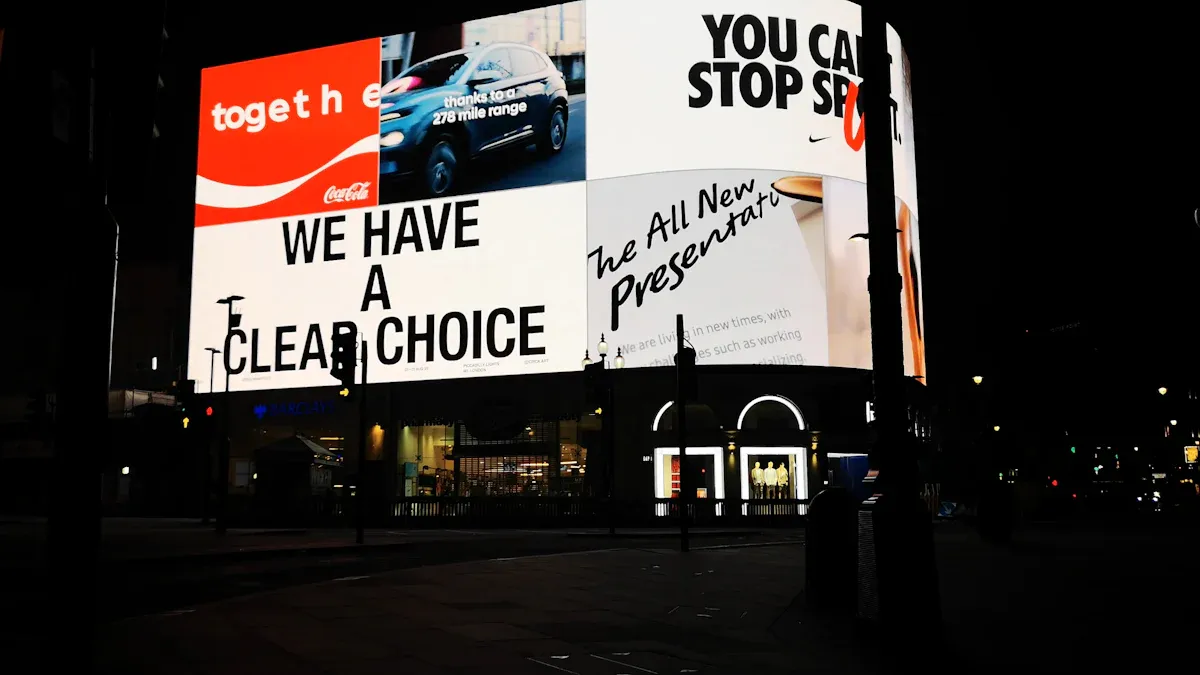
Digital signage stands are important tools for today’s marketing.
These stands hold screens that show moving content to attract people.
They grab 400% more attention than regular posters or signs.
About 76% of shoppers say they entered a store after seeing one.
Businesses using digital signage often see sales go up by 31.8%.
Digital signage helps connect with customers and share specific messages.
People remember 83% more from digital displays than from emails.
Digital menus or ads make waiting feel 35% shorter for customers.
This improves how customers feel about their overall experience.
Key Takeaways
Digital signage stands help get more attention than regular signs. They grab 400% more interest from customers.
Picking the right stand type—floor, wall, or ceiling—makes messages easier to see and understand. This helps with better communication.
Interactive stands let people touch and use the screen. These stands make experiences fun and can boost sales and customer happiness.
Choose strong and durable stands. Good materials last longer and save money on repairs.
Plan your budget carefully. Think about all costs, including upgrades, to buy a stand that fits your business needs.
Types of Digital Signage Display Stands

Digital signage stands come in different styles for various needs. Picking the right stand helps show your content clearly. This boosts customer interest and shares strong messages. Below are three common types: floor stands, wall mounts, and ceiling mounts.
Floor Stands
Floor stands are very flexible and easy to use. These stands work well in busy places where people pass by often. You can put them in stores, lobbies, or events to show ads, directions, or updates.
Tip: Place floor stands at eye level for better visibility.
Many floor stands have wheels, so you can move them around. This makes them great for places where displays need to change spots often. They also fit many screen sizes, from small tablets to big displays.
Metric | What It Does |
|---|---|
Makes screens easy to see, even in bright light. | |
Contrast Ratio | Helps text and images stand out clearly. |
Viewing Angle | Lets people see the screen from different sides. |
Color Accuracy | Shows bright, true colors to grab attention. |
Wall Mounts
Wall mounts save space and look neat. These stands attach to walls, making them perfect for tight spaces like hallways or waiting rooms. They give a clean, professional look to your digital screens.
You can pick fixed, tilting, or moving wall mounts. Fixed ones stay flat on the wall. Tilting and moving mounts let you adjust the screen angle. This helps people see the content better in tricky spots.
Wall mounts are popular in stores and hotels. Restaurants use them for menus, while hotels display guest info or ads.
Ceiling Mounts
Ceiling mounts are great when floor or wall space is limited. These stands hang screens from the ceiling, making them easy to see in big areas like malls or airports.
Ceiling mounts show content high up, so it catches attention from far away. This makes them ideal for signs, ads, or updates in crowded places.
They are strong and steady, even in busy areas. Many models let you change the height or angle for better viewing.
Type of Digital Signage | Benefits | Retail Uses |
|---|---|---|
LED Displays | Bright and clear visuals | Storefront ads |
Digital Posters | Affordable and simple | Seasonal sales |
Interactive Kiosks | Fun and engaging | Product details |
Projection Signage | Immersive experiences | Special in-store events |
Each type of stand has its own strengths. Knowing their uses helps you pick the best one for your needs.
Kiosks
Kiosks are standalone digital signage tools made for direct user interaction. They often have touchscreens, making them great for places needing customer engagement. You can find kiosks in stores, airports, and museums. They help with tasks like browsing products, buying tickets, or finding directions.
Kiosks are excellent for showing personalized content. Users can pick what they want to see, creating a custom experience. For example, in stores, kiosks can show product lists or virtual fitting rooms. In airports, they let travelers check schedules or buy tickets quickly.
Tip: Put kiosks in busy spots to get more attention.
These displays are strong and can be customized. You can add your logo or colors to match your brand. Their tough design makes them last long, even with heavy use. This makes them a dependable choice for businesses.
Portable Stands
Portable stands are lightweight and easy-to-move digital signage options. They work well for events, exhibits, or temporary setups. You can quickly move them to different spots to reach your audience.
Portable stands save 35% of setup time, making them great for fast-paced events. They are 50% more flexible, letting you adjust to changes easily. By 2026, the market for portable stands is expected to grow to $27.8 billion.
Metric | Value |
|---|---|
Market Growth Projection | $27.8 billion by 2026 |
Flexibility Increase | 50% |
Setup Time Reduction | 35% |
These stands can hold small or large screens. Their compact size fits tight spaces while still looking professional. Use portable stands for ads, event schedules, or directional signs.
Note: Pick portable stands with adjustable height for more flexibility.
Interactive Stands
Interactive stands turn watching into active participation. These digital signage displays have touchscreens for user interaction. They are great for schools, hospitals, and stores where involvement improves the experience.
In classrooms, interactive screens make learning fun. Students can explore lessons, take quizzes, or work on group projects. In hospitals, they help patients check in, find health info, or navigate buildings. Stores use them to show product details, reviews, or virtual try-ons.
Callout: Interactive stands make customers happier by giving hands-on experiences.
These stands mix style with usefulness. Their modern look fits well in updated spaces, and their sturdy build ensures they last. You can customize them with your brand’s colors and logo for a unified look.
Interactive stands are great for showing exciting content. They encourage users to spend more time interacting, which can lead to more sales or positive feedback.
Customizable Stands
Customizable stands are flexible and fit different business needs. These digital signage stands let you change their design, size, and features. Whether for a store, office, or event, they match your brand style.
Why Pick Customizable Stands?
Customizable stands help you create a unique look. You can change their height, color, or add branding to stand out. For example, adding your logo or colors makes them look professional. They work with many types of screens, like touchscreens or regular displays.
Tip: Use these stands to show your brand clearly and consistently.
Features of Customizable Stands
Customizable stands have useful features that make them practical:
Adjustable Dimensions: Change the size to fit small or big screens.
Branding Options: Add logos or designs to match your marketing.
Material Choices: Pick strong materials like metal or wood for durability.
Mobility Enhancements: Add wheels or lightweight designs for easy moving.
Feature | Benefit |
|---|---|
Adjustable Height | Makes screens easier to see |
Branding Elements | Boosts brand recognition |
Durable Materials | Lasts longer with heavy use |
Mobility Options | Easy to move around |
Where to Use Customizable Stands
Customizable stands are great in many places. Stores use them to show sales or product info. Offices display updates or schedules. At events, they attract visitors to your booth. In busy areas like airports, they give directions or updates.
Tips for Using Customizable Stands
To use these stands well, think about your audience and space. For crowded areas, pick strong materials that last. If you want to engage people, choose touchscreens for interaction. Always make sure your content matches your brand and connects with viewers.
Callout: Customizable stands mix branding with practical use for businesses.
By choosing customizable stands, you get tools that adapt to your needs. They make your displays look better and help connect with customers.
Applications of Digital Signage Displays Across Industries
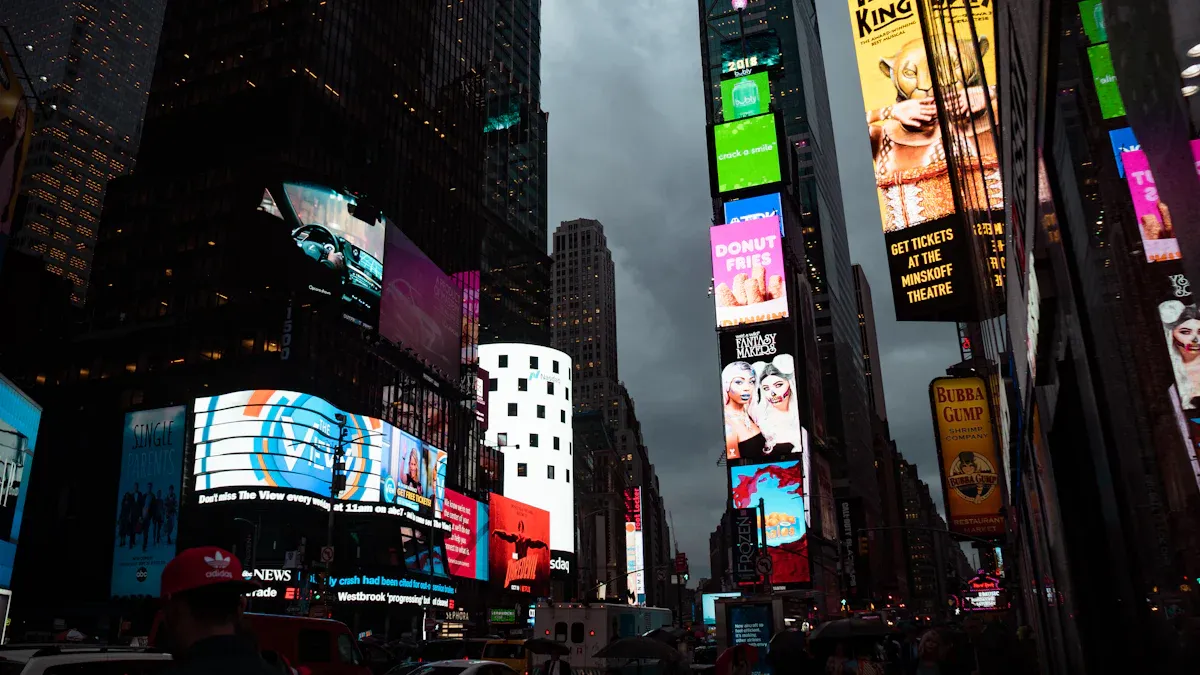
Digital signage has changed how businesses talk to their audiences. From stores to hospitals, these screens improve experiences and share engaging messages. Below are some ways industries use digital signage.
Retail
Digital signage is very helpful in stores. It grabs attention, shows products, and makes shopping better. Stores use screens to display sales, new items, and suggestions. Touchscreens and maps help customers find their way around.
Metric | Value |
|---|---|
Sales increase | 29.5% |
Ad recall boost | 52% |
Customers influenced by signage | 70% |
Customer satisfaction rise | 46% |
Chance of entering stores with displays | 80% |
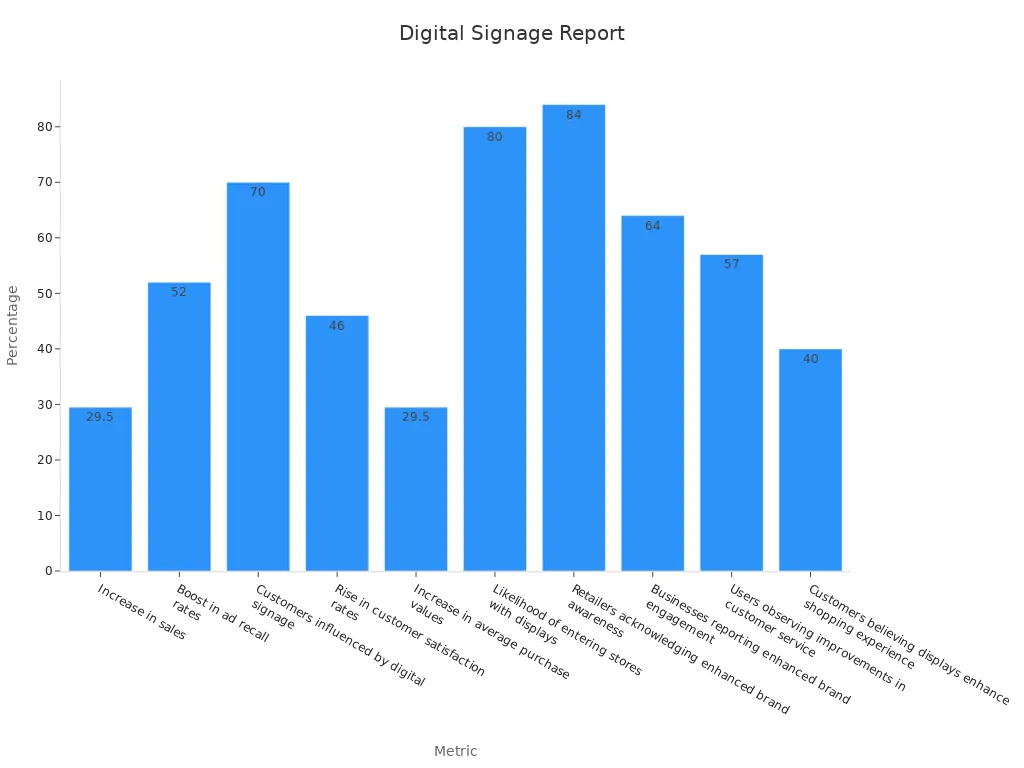
Stores say 84% of shoppers notice their brand more with signage. Screens also raise average spending by 29.5%. Using digital displays creates a fun shopping space that keeps people interested.
Hospitality
Hotels and restaurants use digital signage to improve guest experiences. Hotels show check-in steps, event details, and nearby attractions. Restaurants use screens for menus, specials, and to make waiting feel shorter.
Statistic | Value |
|---|---|
Customer satisfaction increase due to signage | 46% |
Diners liking restaurant technology | 73% |
Restaurateurs saying tech helps business | 95% |
Customers influenced by digital menus | 29.5% |
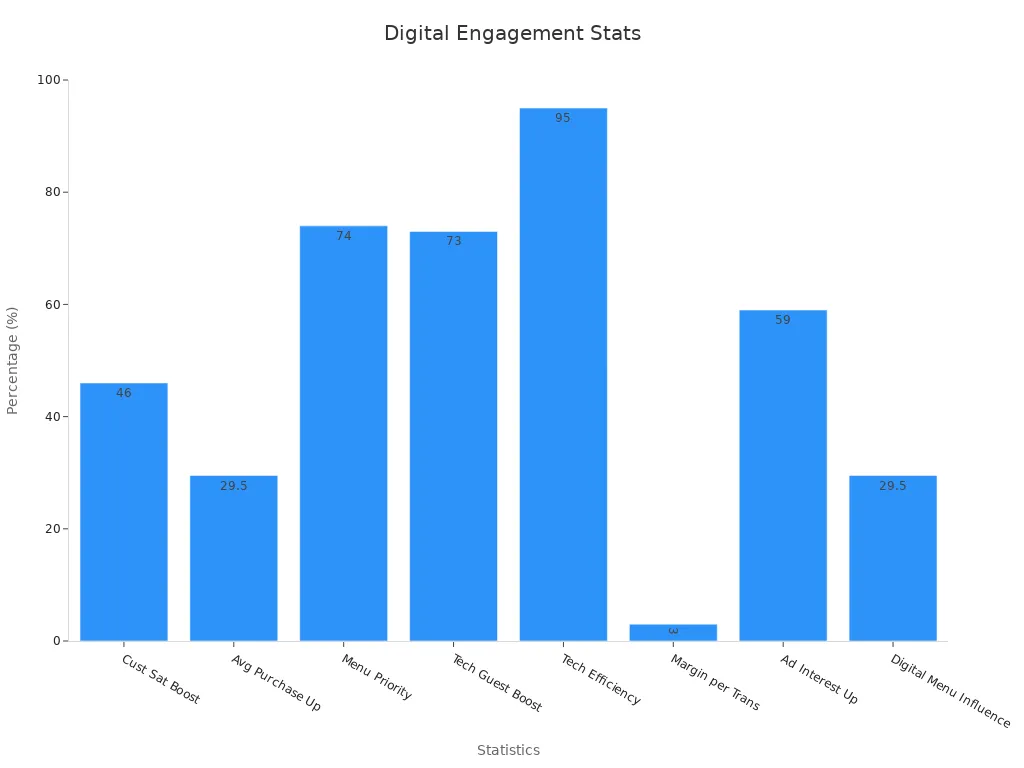
Touchscreens in lobbies or dining areas let guests explore services or book reservations. About 30% of diners say digital menus help them choose food. Adding signage to hospitality businesses boosts guest happiness and income.
Healthcare
Hospitals use digital signage to share information and save time. Screens in waiting rooms show health tips, updates, and maps. This helps patients feel calm and informed. Touchscreens let patients check in, find directions, and see content in different languages.
Digital signage reduces staff work by automating messages.
Screens deliver personalized info using smart technology.
Multilingual options make content accessible for everyone.
Healthcare providers use signage to make visits smoother and more welcoming. These displays create a better experience for patients and staff alike.
Education
Digital signage is very helpful in today’s classrooms. It changes old teaching methods into fun and exciting ones. Schools use digital screens to show announcements, schedules, or learning materials. These displays make lessons more fun and easier to understand.
Touchscreens are great tools for schools. They let students join lessons actively. For example, students can use them for quizzes, group work, or virtual trips. This hands-on way of learning keeps students focused and working together.
Libraries also use digital signage in smart ways. Screens can show new books, upcoming events, or open study rooms. These displays help students find what they need and stay organized.
Tip: Put screens in busy spots like hallways or cafeterias for better visibility.
Digital signage helps teachers, students, and parents stay connected. Schools can use these screens to share updates, alerts, or event news. This keeps everyone informed and on the same page.
Corporate Offices
Digital signage makes offices more productive and connected. Companies use screens to share updates, meeting times, or motivational quotes. These tools help workers feel informed and part of a team.
Here are some facts about digital signage in offices:
Statistic | Description |
|---|---|
56% | Teams plan to use more digital signage for better communication. |
50% | Professionals rely on digital signage for sharing information. |
60% | Workers feel valued through signage and work harder. |
25% | Good communication boosts productivity in companies. |
4x | Clear communication increases employee engagement. |
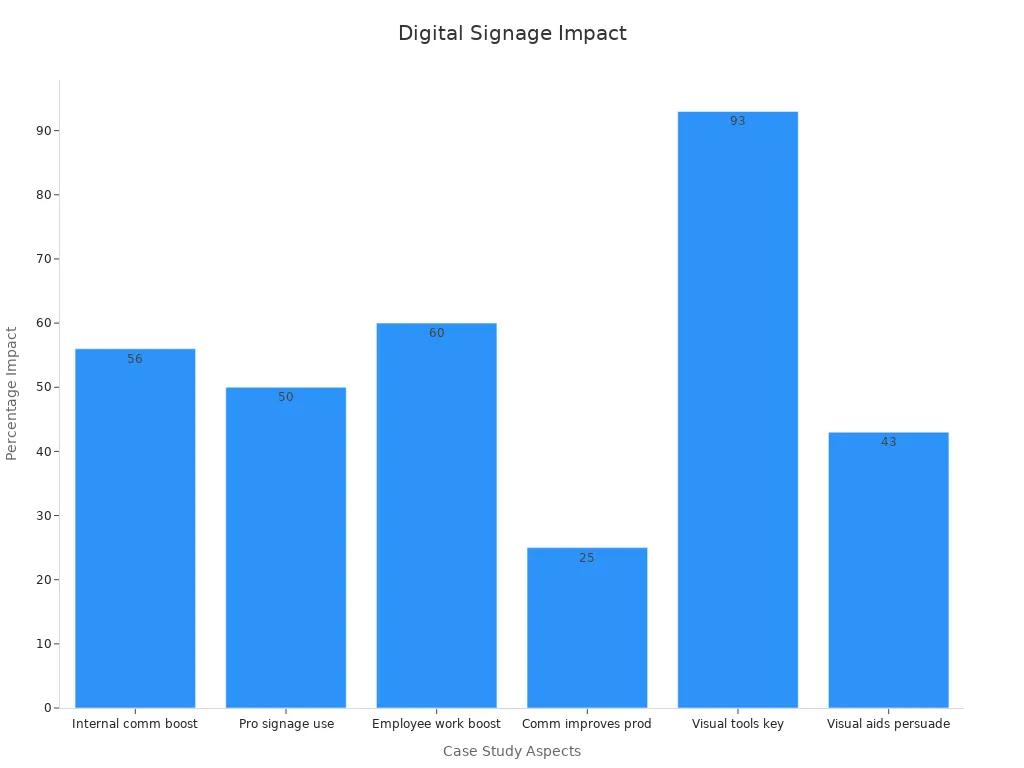
Touchscreens in break rooms or lobbies can show company wins or employee shoutouts. This makes workers feel proud and part of the team. You can also use screens to guide visitors or share your company’s values.
Callout: Using digital signage for clear messages keeps employees happy and reduces turnover.
Events and Exhibitions
Digital signage makes events and exhibitions more exciting. Screens can guide guests, show schedules, or promote sponsors. These tools help events run smoothly and look professional.
Portable stands work well for temporary setups. They are easy to move and adjust. Use them for signs, event updates, or touchscreens to engage guests.
Note: Pick stands that adjust to fit different screen sizes and layouts.
Digital signage at exhibitions creates fun experiences. Use screens to show product demos, videos, or live social media posts. This grabs attention and keeps people interested. Adding your logo or colors to the screens strengthens your brand.
Interactive screens make events more engaging. For example, you can use them for surveys, games, or virtual tours. These features make your booth unique and memorable for visitors.
Transportation Hubs
Airports, train stations, and bus terminals use digital signage to help travelers. These busy places have thousands of people every day. Signs make it easier to find your way and stay updated on schedules or delays.
A key use of digital signage is showing real-time updates. Screens display flight times, gate changes, and boarding info. This keeps you informed without needing to ask for help.
Tip: Put signs near entrances, ticket counters, and waiting areas for better visibility.
Interactive kiosks are also common in these hubs. They let you check in, print tickets, or find your gate. This reduces lines and makes traveling easier. Some kiosks even offer multiple languages to help international travelers.
Advertising is another use for digital signage in these places. Since many people pass through, brands show ads to catch their attention. These ads promote products or services while travelers wait.
Feature | Benefit |
|---|---|
Real-time Updates | Keeps travelers informed |
Interactive Kiosks | Makes check-in faster |
Multilingual Support | Helps international visitors |
Advertising Opportunities | Reaches many people |
Using digital signage in transportation hubs saves time and improves travel. Whether flying or taking a train, these tools keep you informed and engaged.
Selection Criteria for Digital Signage Display Stands
Picking the right digital signage stand helps show your content well. It also supports your business goals. Think about these key points before choosing.
Compatibility with Display Screens
The stand should fit the size and type of your screen. Whether it’s a regular display or a touchscreen, the stand must hold it safely. Make sure the stand can handle your screen’s weight and size.
Some stands have adjustable parts to fit different screen sizes. This is helpful if you plan to upgrade your screens later. For touchscreens, pick stands that stay steady when people use them. This stops the screen from shaking.
Tip: Check if the stand works with your screen’s mounting pattern, like VESA, to avoid setup problems.
Durability and Material Quality
Strong materials are important for digital signage stands, especially in busy places. Stands made of steel or aluminum last longer and handle wear and tear well. For outdoor use, pick weatherproof materials to protect your screens.
Plastic stands are light and easy to move but may not hold heavy screens well. Look at the stand’s quality to make sure it’s safe and durable.
Material Type | Benefits | Best Places to Use |
|---|---|---|
Steel | Strong and stable | Stores, transportation hubs |
Aluminum | Light and rust-resistant | Events, exhibitions |
Plastic | Cheap and portable | Temporary setups |
Callout: Good materials save money on repairs and make your stand last longer.
Aesthetic Design and Branding
How the stand looks affects how people see your signage. A nice-looking stand makes your content stand out and supports your brand. Pick a design that matches your business style and branding.
Studies show that design choices affect how people view brands. For example, modern stands show innovation, while wooden ones feel warm and traditional. Choose a stand that fits your audience’s taste.
Customizable stands let you add logos and colors to match your brand. This makes your signage look professional and easy to recognize. Rating designs with numbers can help you pick the best one for your brand.
Tip: Choose stands with simple designs and neutral colors to match your screens and content.
Ease of Installation and Maintenance
Picking a digital signage stand that’s easy to set up is important. A simple setup saves time and effort. Many stands come with pre-made parts or clear guides. This makes putting them together quick and easy. Choose stands with universal mounts that fit most screens. These mounts let you attach displays without special tools.
Taking care of the stand matters too. Good designs make cables and ports easy to reach. Some stands have systems to keep wires neat and hidden. This makes the setup look better and prevents damage. Cleaning and small fixes are easier with these features.
Tip: Pick stands with quick-release parts. They make changing screens faster, especially in busy places.
Strong materials also mean less upkeep. Rust-proof metals or tough plastics last longer. For outdoor use, pick stands with coatings to protect from rain or sun. A stand that’s easy to install and maintain saves money over time.
Mobility and Flexibility
Being able to move and adjust digital signage stands is useful. Portable stands let you move displays to different spots easily. Many have wheels for smooth transport. Look for stands with locks to keep them steady when placed.
Adjustable stands are helpful for better viewing. You can change the height or tilt for clear visibility. This is great for touchscreens where people interact with the content. Some stands swivel or rotate, letting you switch between vertical and horizontal views.
Callout: Flexible stands work well for events or pop-up shops needing frequent changes.
Compact and foldable stands save space and are easy to store. They’re perfect for tight areas or temporary setups. Whether in offices or busy hubs, mobility and flexibility help your content reach more people.
Budget Considerations
Your budget affects which digital signage stand you pick. Cheaper stands may seem good, but quality ones last longer. Strong and adjustable stands save money by needing fewer replacements.
Think about what you need. For outdoor use, spend more on weatherproof materials. For indoor low-traffic areas, basic stands might be enough. Compare features like mobility and adjustability to find the best value.
Tip: Save part of your budget for future upgrades. This keeps your stand ready for newer screens.
Look at the total cost, not just the price tag. Some stands need extra parts like brackets or cable holders. Add these costs to your budget to avoid surprises. By balancing price and features, you can pick a stand that fits your needs without overspending.
Environmental Factors
When picking digital signage, think about its effect on nature. Newer displays are made to be greener, but your choices can make them even better. By focusing on saving energy, using eco-friendly methods, and recycling properly, you can lower their impact on the environment.
Energy Efficiency
Energy-saving screens, like LED ones, use much less power. They need about 30% less energy than older types, making them a smart pick for businesses. Features like sleep mode and light sensors save even more power when not in use. This cuts electricity bills and reduces pollution.
Tip: Choose screens with an Energy Star label. They follow strict energy-saving rules and help you save money.
Sustainable Practices
Switching to digital signage means no more printed signs, saving paper and ink. This helps protect trees and keeps trash out of landfills. Using solar panels or other green energy sources can also power your screens. This saves money and helps the planet.
Practice | Benefit |
|---|---|
Energy Star certified displays | Use less electricity and save money. |
Power-saving features | Cut energy use when screens are idle. |
Renewable energy integration | Reduce costs and help the environment. |
Lifecycle assessments | Find ways to save more energy. |
Responsible disposal practices | Lower waste and energy use. |
Responsible Disposal
When your screens wear out, recycle them the right way. Recycling parts saves energy and keeps harmful waste out of dumps. Many companies offer programs to take back old screens for proper recycling.
Callout: Recycling old screens helps keep the air clean and the planet healthy.
Environmental Benefits of Digital Signage
Digital signage has many eco-friendly perks over regular signs. LED screens use less power, and lower energy needs mean cleaner air. Touchscreens and other digital tools replace printed materials, saving natural resources. These benefits make digital signage a great choice for businesses that care about the planet.
Digital signage saves paper, protecting forests and reducing trash.
Using less energy means fewer harmful gases in the air.
Switching to digital signage removes the need for printed signs, saving resources.
By thinking about these environmental factors, you can make smart choices for your business and the planet. Picking energy-saving screens, using green methods, and recycling properly will help you lower your impact while sharing great content with your audience.
Picking the right digital signage stand is very important. It helps show your content clearly and keeps customers interested. Think about what your business needs and your goals. Tools like data tracking can show trends and help you choose the best stand. Custom stands let you match your brand, and integration features make sure it works with other systems.
Plan your budget wisely. Look at the total cost, including materials and upgrades. Use charts or graphs to compare choices and find the best deal. Match your stand to your business needs to get the most out of it. This way, your signage will grab attention and share your message well.
FAQ
What type of digital signage stand works best in small spaces?
Wall mounts are great for tight areas. They save floor space and look neat. You can pick fixed, tilting, or adjustable ones to suit your needs. These mounts work well in hallways, waiting rooms, or small stores.
Can digital signage stands be used outside?
Yes, but choose weatherproof stands. Outdoor stands protect screens from rain, sun, and dust. Look for strong materials like steel or aluminum. Anti-glare screens help people see better in bright light. These features keep your signage useful outdoors.
How do I take care of a digital signage stand?
Clean the stand and screen often with a soft cloth. Check screws and parts to keep it steady. For outdoor stands, look for rust or damage from weather. Keep cables tidy and safe to make the setup last longer.
Are interactive stands worth buying?
Interactive stands let people interact with the screen. They work well in stores, schools, and hospitals. They cost more but give personalized experiences. This often leads to happier customers and better results for businesses.
Can I make a digital signage stand match my brand?
Yes, many stands can be customized. Add your logo, colors, or designs to fit your brand. Custom stands make your business look professional. They are great for events, exhibits, or store displays.
See Also
Exploring Digital Signage Monitors: Tech, Uses, and Choices
Understanding Digital Signage Screens: Specs and Selection Tips
Digital LED Displays: Innovations, Uses, and Key Advantages
Digital Displays: Tech Insights, Advantages, and Implementation Tips
Best Digital Signage Displays: Uses, Benefits, and Future Trends

